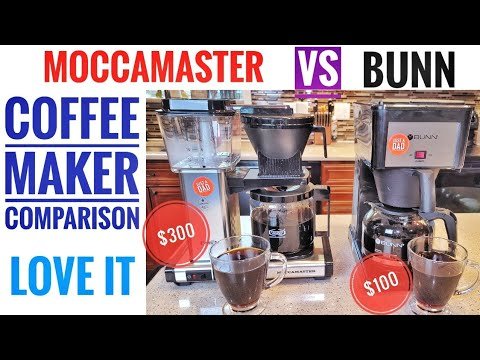
When it comes to brewing coffee at home, the choice of machine can heavily influence both the quality of your morning cup and your overall user experience. Two popular models on the market are the Technivorm Moccamaster and the Bunn Speed Brew Coffee Maker. Both are well-regarded for their performance, but they cater to different preferences and needs. Here’s a detailed comparison to help you decide which might be best suited for your coffee ritual.
**1. Design and Build Quality**
The Technivorm Moccamaster boasts a timeless design with its sleek, minimalist European aesthetics that make it more than just a coffee maker; it’s a statement piece in any kitchen. Handmade in the Netherlands, it features high-quality metal and BPA-free plastic components. The Moccamaster is known for its durability and long life span.
In contrast, the Bunn Speed Brew features a more utilitarian design that focuses on practicality rather than style. It’s built to be robust with a stainless steel water tank and a glass carafe that’s designed for quick brewing. Its design is straightforward, emphasizing ease of use and durability in everyday kitchen environments.
**2. Brewing Technology**
Technivorm’s Moccamaster is equipped with a unique copper heating element that ensures water temperature is maintained between 196°F and 205°F during brewing, which is optimal according to the Specialty Coffee Association (SCA). This precision contributes to superior flavor extraction from the coffee grounds.
The Bunn Speed Brew also uses an internal hot water tank to keep water at an ideal brewing temperature of about 200°F. What sets it apart is its speed; it can brew 10 cups of coffee in about four minutes, thanks to its innovative spray head design that optimizes coffee flavor extraction efficiently during the quick brewing cycle.
**3. Capacity and Flexibility**
The Moccamaster offers various models that cater to different needs, such as single-cup machines or larger options capable of brewing up to 10 cups per cycle. It also allows for customizing brew strength through adjusting water flow—this means you can control how long water stays in contact with coffee grounds.
Conversely, Bunn’s Speed Brew line primarily focuses on multi-cup models designed for family or office use, capable of brewing anywhere from 4 to 10 cups at a time depending on the model chosen.
**4. Ease of Use**
Both machines are relatively simple to operate but cater slightly differently in user interaction levels required:
– The Technivorm Moccamaster has separate compartments for water and coffee grounds, requiring manual setup before each brew session but ensuring more control over every step.
– The Bunn Speed Brew features a more straightforward operation where users just need to pour water into an inlet funnel when they want fresh coffee – making it ideal for those who prefer convenience over customizability.
**5. Sustainability and Clean-up**
Sustainability-wise, both brands offer certain advantages. The Technivorm’s materials ensure longer durability which means less waste over time while parts are recyclable once it reaches end-of-life stage after many years of service.
Cleaning both devices involves regular descaling treatments due either natural mineral build-ups from tap or filtered waters used during brewing cycles – easy enough maintenance tasks but essential non-the-less ensuring optimal performance throughout their lifespans.
**6. Price Point**
There’s quite disparity pricing between these two: where Technivorm MoccaMaster generally commands higher price tags due these being considered premium handcrafted appliances versus somewhat lower cost points found across various models available under Bunn Speed Brew series – something potential buyers must consider based off budget constraints versus desired quality outcomes expected out their chosen appliances long term investments into their daily drinking habits or entertainment hosting needs alike!
Ultimately choosing between these two stalwarts comes down individual preferences regarding aesthetics automation levels desired workload willing assume part maintaining regular operations alongside monetary investment considerations anticipated return values given respective expenditures incurred upfront periods extended usage scenarios contemplated ahead purchase decisions made final accordingly thereafter!